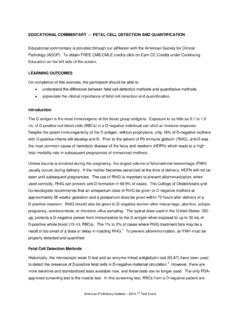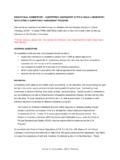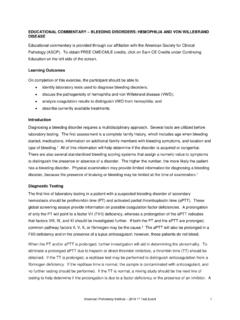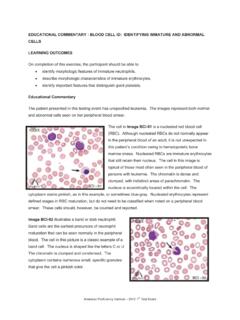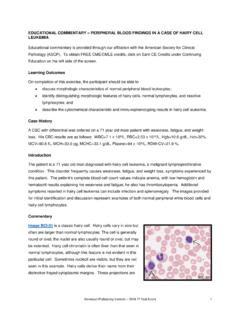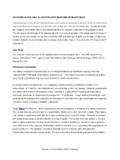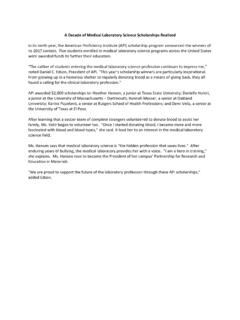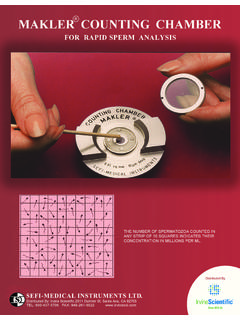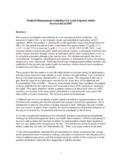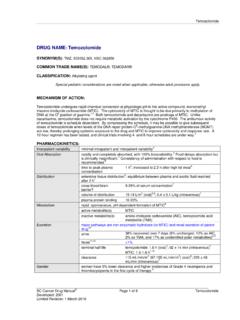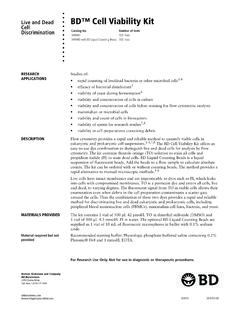Transcription of Automated Urine Particle Analysis Methods (2011)
1 EDUCATIONAL COMMENTARY Automated Urine Particle Analysis Methods . Educational commentary is provided through our affiliation with the American Society for Clinical Pathology (ASCP). To obtain FREE CME/CMLE credits click on Earn CE Credits under Continuing Education on the left side of the screen. LEARNING OUTCOMES. After completing this exercise, the participant should be able to describe two technologies used in Automated Urine Particle analyzers. discuss the performance strengths and weaknesses of each Automated method. The disadvantages of analyzing Urine particles by conventional manual microscopy are well known. Manual microscopy is time-consuming, requires technical expertise, and lacks precision owing to variations in sediment preparation and counting technique.
2 In contrast, Automated Urine Particle analyzers offer rapid results, require less technical expertise to operate, and provide standardized counting and reporting. Currently in the United States, two manufacturers, IRIS Diagnostics (Chatsworth, CA, USA) and Sysmex Corporation (Kobe, Hyogo 651-0073, Japan) sell Urine Particle analyzers. The systems produced by these manufacturers use two different Methods : image-based flow cytometry and fluorescence flow cytometry. Both technologies perform suitably, but they do not yet completely eliminate the need for manual microscopy on some samples. Description of technologies Urine Particle analyzers manufactured by IRIS Diagnostics use an image-based technology.
3 In these systems, Urine particles pass through a planar flow cell in the object plane of a microscope. A strobe light freezes the motion of the particles as they are photographed. For each sample the analyzer captures 500. images. Auto- Particle recognition (APR ) software classifies the photographed particles based on their size, shape, contrast, and structure. The images can be viewed on a computer monitor and verified or edited by the operator, and results can be reported as particles per high-power field or particles per microliter. Sysmex Urine Particle analyzers use fluorescent flow cytometry with a diode laser as a light source. First, Urine particles are stained with fluorescent dyes, which bind to nucleic acids.
4 After hydrodynamic focusing, the particles pass individually through one flow cell that analyzes microorganisms and one flow cell that analyzes all other Particle elements. The particles ' passage through the laser beam creates a diffusion signal produced by both forward- and side-scattered light and a fluorescent signal. The forward rd American Proficiency Institute 2011 3 Test Event EDUCATIONAL COMMENTARY Automated Urine Particle Analysis Methods (cont.). scatter gives information on the Particle size. The side scatter gives information on the surface and internal complexity, and the fluorescent signal gives information on nucleic acid contents. Software synthesizes this information to identify the Particle .
5 Results can be reported as particles per field of view or particles per microliter. Performance benefits and limitations Evaluations of the IRIS iQ200 (IRIS Diagnostics, Chatsworth, CA, USA), the state-of-the-art image-based Urine Particle analyzer, have found that this instrument performs well at detecting and identifying red blood cells (RBCs), white blood cells (WBCs), epithelial cells, and most casts. Wah and colleagues1. found that, when compared to manual microscopy, agreement rates for identifying normal RBCs, WBCs, and epithelial cells ranged from 92% to 100%. The agreement rates for identifying abnormal cells were slightly lower, ranging from 76% to 86%. Wah and colleagues also noted that the IRIS iQ200 yielded lower cell counts than manual microscopy, a finding that they did not believe was caused by inaccuracies in manual cell counts.
6 Also, precision declined with lower cell counts. Finally, the IRIS iQ200 classified some dysmorphic RBCs, ghost cells, and disintegrating WBCs as artifacts, and occasionally misidentified yeast and calcium oxalate crystals as RBCs. In another study, van den Broek and colleagues2 found that the IRIS iQ200 overestimated the numbers of crystals and yeasts. Shayanfar and colleagues3 and van den Broek and colleagues2 found that the analyzer had difficulty identifying bacteria owing to limitations in the software library, specifically the inability to classify cocci. All investigators found that the instrument detected more hyaline casts than manual microscopy did, but detail in the images was not always adequate to differentiate among cellular casts.
7 To compensate for these limitations, investigators recommended manual review for yeasts, WBC clumps, Trichomonas, oval fat bodies, dysmorphic RBCs, and differentiation of casts and crystals. They also concurred with the manufacturer's recommendation to manually review particles classified as artifacts if the Urine protein level is 2+ or greater. Evaluations of fluorescent flow cytometry instruments have also shown limitations. Manoni and colleagues4 found that the state-of-the-art Sysmex analyzer, the UF-1000i, (Sysmex Corporation, Kobe, Hyogo 651-0073, Japan) sometimes had difficulty identifying dysmorphic RBCs and ghost cells and quantifying RBCs in specimens with low cell counts.
8 The system also did not consistently distinguish yeasts, crystals, and sperm cells from RBCs, because these sometimes overlap in the scattergram. Despite these limitations, however, overall correlation with manual RBC counts was good and the data showed improved performance over earlier models. The UF-1000i also performed well at detecting WBCs and epithelial cells and, because flow cytometry technology detects DNA, it can identify even fragmented WBCs. Investigators found that the UF-1000i was less able to detect and identify cellular casts. False positive and false negative results were caused by the presence of mucus and the rd American Proficiency Institute 2011 3 Test Event EDUCATIONAL COMMENTARY Automated Urine Particle Analysis Methods (cont.)
9 Destruction of casts, respectively. Overall, however, samples that were reported as negative for casts by the analyzer had a 99% probability of being reported as negative for casts by conventional microscopy. Despite their limitations, both technologies offer five important benefits over traditional manual microscopy of Urine sediment. First, both Methods provide greater accuracy and precision than manual microscopy, especially at higher cell counts. Second, both technologies offer opportunities to improve standardization of Urine Particle Analysis . For example, Automated systems can determine the absolute number of cells per field or volume, which eliminates the variability found in manual cell counts.
10 Third, modern Urine Particle analyzers can store up to 10,000 patient results with images or graphics, which simplifies retrieving and reviewing results. Fourth, by reducing specimen handling, Automated systems improve operator safety. Finally, both technologies substantially reduce the time required to produce a result. Both the IRIS iQ200 and the Sysmex UF1000i can process up to one hundred specimens per hour, and Shayanfar and colleagues estimated that the operator time required by both the IRIS iQ200 and the Sysmex UF-100 averaged less than thirty seconds per Conclusion The decision whether to buy an Automated system or use manual microscopy will depend on a careful Analysis of the costs and expected impact on revenues.

